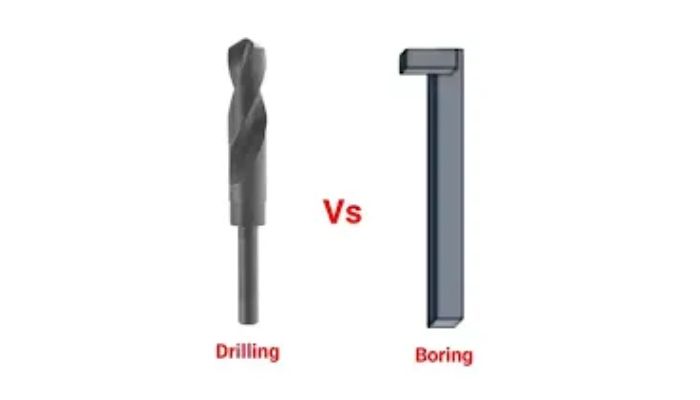Hello, everyone. Today, we’ll explore the distinctions between drilling and boring operations.
Drilling and boring are machining operations commonly performed using a drilling machine. In our earlier discussion about drilling machines, we covered both drilling and boring operations. However, in this section, we will focus specifically on understanding the distinctions between drilling and boring.
Let’s proceed to explore the differences without delay.
What is Drilling?
Drilling is a machining process where material is removed from a workpiece to form a hole. This method utilizes a rotating drill bit to cut into the material and create an opening. The process is commonly employed across diverse industries and materials, including metals, wood, plastics, and composites.
Read also: Types of Cutting Tool Materials and Their Properties
What is Boring?
Boring is a machining process focused on enlarging an existing hole, typically one formed by a prior method like drilling or casting. This technique involves refining the dimensions of a hole to achieve specific size requirements or to enhance its precision.

What is Difference between Drilling and Boring?
There are the following 11 common differences between drilling and boring.
Drilling and boring are both machining processes used to create holes in materials, but they differ in their purposes, methods, and the types of holes they produce. Here are the key differences between drilling and boring:
| Drilling | Boring |
|---|---|
| The drilling operation is done through the drilling machine to generate a hole. | Boring operation is performed to enlarge the diameter of the existing hole which means it is always performed after drilling. |
| The cutting tool used for drilling in a drilling operation is known as a drill bit. | The cutting tool used for boring operations is known as the boring bar. A boring bar basically is a heavy metal bar with tools attached to the end. |
| The drill can extend the length of the hole and its diameter is limited by the drill diameter. | Boring can increase the diameter of the existing hole. |
| The holes produced by drilling operations are generally cylindrical in shape and circular in diameter. However, some specialized drill bits can form shapes other than cylindrical such as a conical shape. | Since the boring process is similar to internal turning hence also taper holes can be easily made by boring. |
| Drilling is the first step for hole machining. However, sometimes centralization is done before drilling. | Boring cannot be done if there is no drilled hole or hollow part. |
| The drill is meant to plunge effectively into the workpiece. So the axial length of the hole can be increased by the drilling operation. | Plunging is not possible with a boring tool. Therefore the length of the hole cannot be increased by boring. |
| The drill is a multi-point cutter. This means that the drill has two or more cutting edges that can simultaneously remove the material. | The boring bar is a single-point cutter, so it has only one main cutting edge that removes material from the workpiece. |
| Tool rating speed is very high in the drilling operations. | Tool rating speed is very low in boring operations. |
| The material removal rate is very high in drilling. | The material removal rate is low in boring operations as compared to drilling. |
| The hole diameter is limited to the drill diameter, in fact, they are exactly the same. | Boring is done only to increase the diameter of the hole. |
| During drilling operations, the hole surface finish is not good. | During boring operations, the hole surface finish is good as compared to drilling. |
In summary, drilling is the process of creating holes from scratch, while boring is focused on refining or enlarging existing holes to meet specific dimensional and precision requirements. Both processes play crucial roles in the field of machining, each serving different purposes based on the desired outcome.
Read also: Manufacturing Process of Steel: 6 Methods of Making Steel
In this discussion, we’ve explored the distinctions between drilling and boring. Feel free to follow us on Google News for more articles on similar topics.
We trust you found this post informative and engaging.
